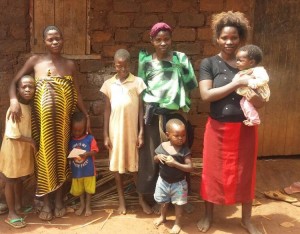Kikondo, UG – Small sustainable steps help families move towards food self-reliance – 2 Jun 2017
 Mama HCM’s first interaction with Wamukisa came in July 2016 when she attended a series of training sessions about water conservation, organic gardening, and SMART goal setting. After attending the training sessions she felt Wamukisa’s organic vegetable gardening program could help her take care of her mother and eight children.
Mama HCM’s first interaction with Wamukisa came in July 2016 when she attended a series of training sessions about water conservation, organic gardening, and SMART goal setting. After attending the training sessions she felt Wamukisa’s organic vegetable gardening program could help her take care of her mother and eight children.
The HCM family lives roughly 300 meters from the nearest water source. Wamukisa warned families during training sessions that vegetable gardens require a lot of water and they would quickly tire of fetching water if they had to walk far for every bucket. In August 2016 Mama HCM attended a training session about how to make a filter to turn waste-water from cooking and cleaning into irrigation water. After building her own filter Mama HCM saw that her large family used more than enough water each day to maintain a single vegetable garden bed so in October 2016 she opened a single trial bed at her home.
Mama HCM’s initial trial bed was successful. She was especially happy about growing French beans, which she had never eaten before. “My children really love to eat them with posho (boiled corn flour),” she says. Following on this success in February 2017 she opened two more beds for a total of three organic vegetable garden beds. So far one bed has already been harvested and she sold 10,000 (US $3.00) UGS of onions.
 Mama HCM’s SMART Goal is to grow enough food to feed her family vegetables every day and to sell at least 5,000 UGS of vegetables per week to help pay for other staples like oil, salt, and flour.
Mama HCM’s SMART Goal is to grow enough food to feed her family vegetables every day and to sell at least 5,000 UGS of vegetables per week to help pay for other staples like oil, salt, and flour.
One of her biggest challenges is water access. During the dry season her production is limited by the amount of water she can filter from home use. She hopes to eventually benefit from Wamukisa’s water project.
Another challenge she faces is time. Currently the most dependable way for her to earn income is to find day labor outside of the home. Working away from home all day makes it difficult for her to tend to garden and larger farm area. She gets paid 5,000 UGS (US $1.50) per day as a day laborer. If she could reliably earn this income from her farm each day she could spend more time investing in her own farm and garden, allowing her to eventually make more than 5,000 UGS each day.

